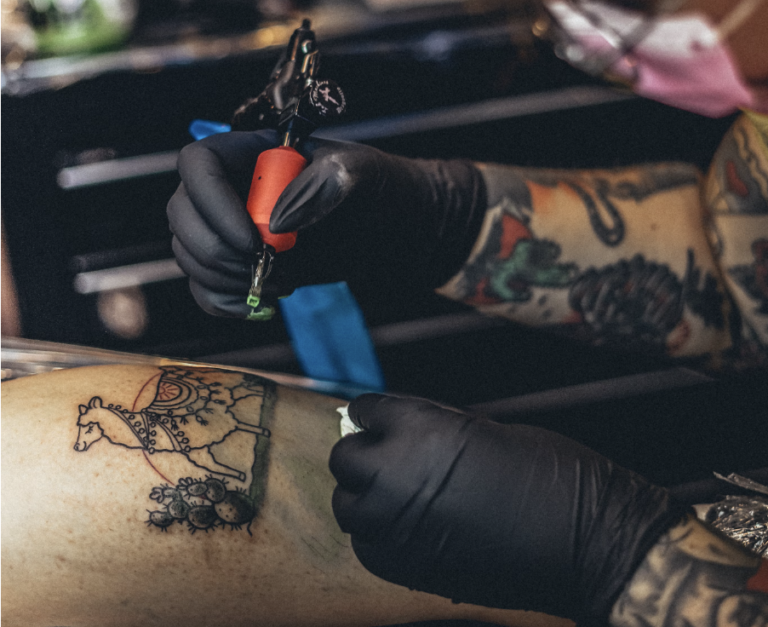You’ve just gotten a fresh tattoo, and it looks amazing. The colors are vibrant, the lines are sharp, and you can’t wait to show it off. But before you dive into the pool or head to the beach, there’s one crucial question on your mind: How long after getting a tattoo can you swim? It’s a common concern, and for good reason. Swimming too soon can lead to complications that nobody wants.
Understanding the healing process of tattoos is essential to ensure your new ink remains pristine. Water bodies, whether it’s a pool, ocean, or even a hot tub, can harbor bacteria that pose a risk to your fresh tattoo. Let’s dive into the details and find out when it’s safe for you to take that celebratory swim without risking your tattoo’s integrity or your health.
Key Takeaways
- Wait Before Swimming: It’s essential to wait a minimum of 2 to 4 weeks before swimming after getting a tattoo to allow for sufficient surface healing. Deeper skin layers might still be recovering during this period.
- Risk Factors: Premature exposure to swimming can introduce bacteria leading to infection, slow down the healing process, affect the tattoo’s appearance through fading or distortion, and expose it to harmful chemicals like chlorine and salt.
- Understanding the Healing Process: The tattoo healing process involves several stages, from initial vibrancy, tenderness, and swelling to itching, flaking, and, finally, complete healing. Proper aftercare is crucial at every stage to ensure a vibrant and healthy tattoo.
- Protective Measures When Swimming: Once healed, use waterproof tattoo covers or high-SPF waterproof sunscreen, limit water exposure time, and cleanse the tattoo before and after swimming to protect the tattoo’s integrity and appearance.
- Consultation and Aftercare: Always follow personalized aftercare instructions provided by your tattoo artist and consult them if you have any concerns during the healing process to ensure your artwork heals beautifully.
- The Importance of Patience: Adhering to the recommended wait times before swimming and taking necessary precautions demonstrates a commitment to the longevity and appearance of your tattoo, ensuring it remains vibrant and infection-free for years to come.
Why waiting to swim after getting a tattoo is important
After getting inked, you’re probably eager to show off your new tattoo at the beach or the pool. However, diving into the water too soon can lead to complications you definitely want to avoid. Understanding the importance of giving your tattoo time to heal before swimming is crucial for both the look of your tattoo and your overall health.
Firstly, a fresh tattoo is essentially an open wound. Like any other wound, it’s vulnerable to infections when exposed to bacteria. Water bodies, such as pools, oceans, and hot tubs, are breeding grounds for bacteria and other microorganisms that can cause serious infections. Even if it looks clean, water can contain harmful pathogens invisible to the naked eye.
Moreover, swimming after getting a tattoo can interfere with the healing process. Chlorinated water found in pools can cause the colors of your tattoo to fade, ruining the appearance of your fresh ink. Saltwater, on the other hand, can dry out your skin and prolong the healing process. Both scenarios can lead to your tattoo healing improperly, leading to distortion of the design or the need for touch-ups.
Additionally, the healing process of a tattoo involves the formation of scabs and peeling skin. When submerged in water, especially for prolonged periods, there’s a risk of softening these scabs, which can detach prematurely. This not only slows down the healing process but can also pull ink out from your tattoo, affecting its overall appearance.
Given these risks, it’s clear why waiting a set period before swimming after getting a tattoo is vital. It protects your skin from infection, ensures the preservation of the tattoo’s appearance, and supports a smooth and quick healing process. Staying dry isn’t just a precaution; it’s a necessary step to ensure your new artwork remains vibrant and healthy for years to come.
The healing process of a tattoo
Understanding the healing process of a tattoo is key to knowing when it’s safe to dive back into your swimming routine. After getting inked, your tattoo goes through several stages before it completely heals. Each stage plays a crucial role in how your tattoo looks and feels in the long term.
Initially, your tattoo will appear vibrant and shiny, but don’t be fooled—this is just the beginning. During the first week, you’ll notice the area is tender, and there might be redness or swelling. This is your body’s natural response to the process, treating the tattooed area like an open wound. It’s vital to follow your tattoo artist’s aftercare instructions to prevent infection and ensure proper healing.
As you move into weeks two and three, your tattoo will start to itch and flake. This is a sign that the healing is progressing, but resist the urge to scratch or peel at the flakes. Doing so can remove pigment from your tattoo and lead to uneven healing. Keep the area moisturized with a fragrance-free lotion recommended by your tattoo artist to manage the itching.
By the fourth week, most of the surface healing should be complete. However, the layers of skin beneath continue to heal. It’s during this time that keeping your tattoo out of the water is crucial. Exposure to chlorine, bacteria, and other chemicals found in swimming pools, oceans, and hot tubs can lead to infections or adversely affect the tattoo’s appearance.
Remember, healing times can vary depending on the size and location of your tattoo, as well as your body’s own healing capabilities. It’s essential to listen to your body and consult with your tattoo artist if you have any concerns during the healing process. By giving your tattoo the time it needs to heal properly, you’ll ensure that your artwork remains vibrant and infection-free for years to come.
Potential risks of swimming too soon
When you’ve just invested time, money, and perhaps a bit of pain into getting a tattoo, it’s crucial to protect that investment by allowing proper healing. Diving into water too soon can expose you to a myriad of complications. Infection tops the list of risks associated with premature water exposure. Bodies of water, even chlorinated pools, are teeming with bacteria and other microorganisms that can enter the open wound created by your new tattoo, leading to serious infections.
Swimming not only increases your risk of infection but also interferes with the healing process. Water-soaked tattoos can experience premature fading, as the water may cause the ink to disperse unevenly beneath the skin. This can result in a tattoo that looks blurred or lacks the vibrant colors you were hoping for. Additionally, chlorine and saltwater can both be harsh on your skin, exacerbating dryness and potentially leading to itchiness and irritation.
Another consequence to be aware of is the softening of scabs that can occur when a new tattoo is submerged in water. This softening might tempt you to peel or scratch at the skin, which can remove ink from the tattooed area and create patchy or incomplete artwork. Moreover, softened scabs lifting prematurely can leave your skin more susceptible to UV damage, which is another factor that can fade your tattoo prematurely.
To sum it up, diving into a pool, ocean, or hot tub too soon after getting a tattoo can put you at risk for a range of issues that go beyond just an infection. Healing tattoos require air and gentle care, not the abrasive or contaminating effects of water immersion. Safeguarding your tattoo from these risks by waiting the recommended period before swimming is essential to ensure your new ink remains vibrant, clear, and infection-free for years to come.
How long should you wait before swimming?
When you’ve just gotten a fresh tattoo, it’s essential to understand the timeline for diving back into your swimming routine. The primary concern is ensuring that your new ink heals properly and avoids any form of infection or damage. So, how long should you actually wait?
Experts in the field of tattoo aftercare strongly advise waiting a minimum of 2 to 4 weeks before swimming. This waiting period allows your tattoo to heal sufficiently on the surface. But keep in mind, while the outer layer might appear healed, the deeper skin layers might still be recovering.
The importance of this waiting period cannot be overstated. During the healing process, your tattoo is vulnerable; think of it as an open wound. Swimming too soon can expose it to various harmful bacteria found in pools, oceans, and even hot tubs. Moreover, water chemicals like chlorine and the salty ocean can be harsh on your new tattoo, potentially leading to irritation, infection, or fading of the ink.
Let’s look at some Key Reasons to wait before taking that dip:
- Risk of Infection: Pools and natural water bodies are teeming with bacteria that can lead to infections in a new tattoo.
- Interference with Healing: Premature swimming can slow down the healing process, affecting the ink’s appearance.
- Chemical Exposure: Chlorine and saltwater can dry out your skin and tattoo, leading to itching and irritation.
While waiting to swim might test your patience, especially during hot summer days, remember that this precautionary step is crucial for the longevity and appearance of your tattoo. Always consult with your tattoo artist for personalized aftercare instructions and adhere to their recommended wait times to ensure your artwork heals beautifully. Your commitment to proper aftercare will pay off when you can finally show off your healed tattoo, swimming worry-free.
Precautions to take when swimming with a new tattoo
Once the waiting period is over and you’re ready to dive in, it’s crucial to take specific precautions to protect your new tattoo while swimming. Tattoos are not just art; they are investments in your skin’s health and appearance. Ensuring they heal properly can make all the difference in maintaining their beauty and longevity.
First and foremost, consider covering your tattoo. Waterproof tattoo covers are available and can offer an added layer of protection between your tattoo and potential irritants in the water. While not foolproof, these covers can significantly reduce the risk of waterborne bacteria coming into direct contact with your healing skin.
Applying a high-SPF waterproof sunscreen over the tattoo can also provide protection, especially from the sun’s harmful UV rays which can prematurely fade your tattoo. Remember, it’s not just the water that can affect your tattoo’s healing and appearance but also the sun exposure during and after swimming.
Limit your time in the water. Even after taking protective measures, it’s wise to keep your swimming sessions short. Extended periods in water can still saturate the skin and potentially affect your tattoo’s healing process. Aim for brief dips to minimize exposure and reduce the risk of complications.
Before and after swimming, cleanse your tattoo carefully with lukewarm water and fragrance-free soap. This step is essential in removing any chlorine, salt, or bacteria that might have come into contact with your tattoo during your swim. Pat the area dry with a clean, soft towel and apply a thin layer of the recommended aftercare product to keep the skin hydrated and promote healing.
By integrating these precautions into your swimming routine, you can enjoy the water without compromising the integrity of your new tattoo. Remember, the better you care for your tattoo, the better it will look as it heals and for years to come.
Conclusion
Waiting the recommended 2 to 4 weeks before diving into pools, oceans, or hot tubs with your new tattoo isn’t just a precaution—it’s essential for ensuring your tattoo heals beautifully and remains vibrant. By understanding that a fresh tattoo is an open wound vulnerable to infections and complications, you’re already on the right path to protecting your investment and your skin. Taking additional steps, such as using waterproof covers and applying high-SPF sunscreen, further safeguards your tattoo against the elements. Remember, patience and proper aftercare are key to enjoying your tattoo’s brilliance for years to come. Always follow the personalized advice from your tattoo artist to ensure the best outcome for your new artwork.
Frequently Asked Questions
How long should I wait before swimming with a new tattoo?
You should wait a minimum of 2 to 4 weeks before swimming with a new tattoo to allow it enough time to heal adequately.
Why is it risky to swim with a fresh tattoo?
Swimming with a fresh tattoo is risky because the tattoo is essentially an open wound vulnerable to infections from bacteria in water bodies. Moreover, swimming can interfere with the healing process, causing the colors to fade and potentially leading to dryness, itchiness, and irritation.
Can swimming affect the appearance of my tattoo?
Yes, swimming too soon can affect your tattoo’s appearance by causing premature fading, and softening of scabs and peeling skin, which can lead to a slower healing process and result in patchy or incomplete artwork.
What are the risks of exposing a new tattoo to chlorine and saltwater?
Exposing a new tattoo to chlorine and saltwater can be harsh on your skin, exacerbating dryness and potentially causing itchiness and irritation. These conditions can interfere with the healing process.
How can I protect my tattoo if I have to swim?
If you must swim, consider using waterproof tattoo covers and applying high-SPF waterproof sunscreen. Additionally, limit your time in the water and ensure to cleanse the tattoo properly before and after swimming to minimize risk.
What should I do to ensure my tattoo heals properly after swimming?
After swimming, cleanse the tattoo area gently but thoroughly to remove any chlorine, salt, or bacteria. Follow personalized aftercare instructions from your tattoo artist, including keeping the tattoo moisturized and avoiding direct sunlight.
Why is personalized aftercare important for a new tattoo?
Personalized aftercare is crucial as it ensures the healing process is optimized for your specific skin type and tattoo. Following your tattoo artist’s aftercare instructions can help prevent infections and ensure vibrant, clear, and healthy tattoos for years to come.







